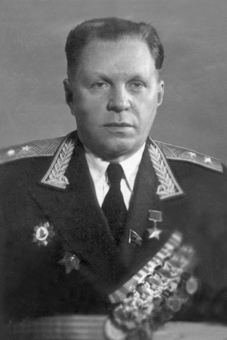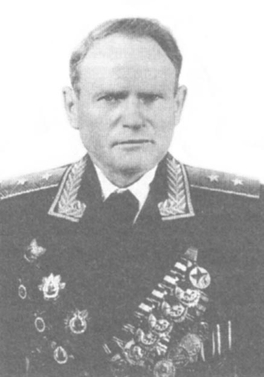The 2nd Rifle Division was a rifle division of the Red Army that served from the Russian Civil War to the Second World War. Originally formed in 1919 from the 1st Ryazansk Rifle Division, the division was twice destroyed and reformed during the war. The division contained two or three rifle regiments.
The 3rd Army was a field army of the Red Army during World War II.
The 4th Rifle Division was an infantry division of the Soviet Union's Red Army, formed three times. It was first formed in 1919 from the remnants of the Lithuanian Rifle Division and fought in the Defence of Petrograd during the Russian Civil War. The division then fought in the Polish–Soviet War. In 1939, the division fought in the Soviet invasion of Poland. It fought in the Winter War from December 1939 and suffered heavy losses in the Battle of Kelja. After Operation Barbarossa, the division fought in the Barvinkove-Losowaja Operation and the 1942 Battle of Voronezh. It suffered heavy losses at Voronezh and was disbanded in November 1942. The division re-formed in 1943 and fought in the Bryansk Offensive, Gomel-Rechitsa Offensive, Lublin–Brest Offensive, Warsaw-Poznan Offensive and Berlin Offensive. It was disbanded in the summer of 1945. The division was re-formed a third time from the 160th Rifle Division and inherited that division's honorifics and awards. It became the 4th Motor Rifle Division in 1957 and disbanded in 1959.
The 73rd Rifle Division was a formation of the Great Patriotic War Soviet Army. The division began assigned to the 20th Army at the beginning of the war and was destroyed and rebuilt twice before the war ended.
The 266th Rifle Division was a rifle division of the Soviet Red Army during World War II. The 266th was formed three times during the war.
The 140th Rifle Division was a Red Army rifle division that saw service during the Great Patriotic War. Originally formed during the prewar buildup of the Red Army, the 140th might be regarded as the unluckiest division in the Army, as it, uniquely, had to be completely, or almost completely, re-formed three times between 1941 and 1943, being destroyed in the Uman pocket during Operation Barbarossa, the Vyasma pocket during Operation Typhoon, and on the Caucasian steppes in the face of the German summer offensive of 1942. In spite of this, the fourth formation of the 140th went on to have a very distinguished record in combat, a testament to the resiliency of the Red Army in World War II.
The 33rd Rifle Division was a rifle division of the Red Army and Soviet Army, formed twice. The division was formed in 1922 at Samara and moved to Belarus in the next year. It fought in the Soviet invasion of Poland in September 1939 and in the Occupation of Lithuania in June 1940. After Operation Barbarossa, the division fought in the Baltic Operation and Leningrad Strategic Defensive. In January 1942, it fought in the Toropets–Kholm Offensive. The division participated in the Leningrad–Novgorod Offensive, the Pskov-Ostrov Offensive, the Tartu Offensive and the Riga Offensive. In 1945, the division fought in the East Pomeranian Offensive and the Battle of Berlin. The division remained in Germany postwar with the Soviet occupation forces and disbanded in 1947. In 1955, it was reformed from the 215th Rifle Division in the Far East and inherited that division's honorifics, but was disbanded in 1956.
The 146th Rifle Division was formed for the first time as a standard Red Army rifle division in mid-1939, as part of a major build-up of the Army prior to the start of World War II. After the start of the German invasion in 1941 it defended the approaches to Kiev for several months until being surrounded and destroyed in September. A second formation began in January 1942, and the new division spent the following year on a relatively quiet sector before joining the offensives that would drive the German invaders from north-central Russia, Lithuania, and Poland. The 146th ended the war fighting in the streets of Berlin, after compiling an enviable record of service, and saw postwar duty in the Group of Soviet Forces in Germany.
The 137th Rifle Division was an infantry division of the Red Army in World War II. Raised in 1939 as a standard Red Army rifle division, it served for the duration of the Great Patriotic War in that role. The division fought in the central part of the Soviet-German front. It shared credit with other formations for the liberation of Bobruisk during Operation Bagration, and ended the war in the conquest of East Prussia.

Andrey Matveyevich Andreyev was a Soviet Army Colonel general and Hero of the Soviet Union. Andreyev joined the Soviet Border Troops in 1924 and became an officer. After graduating from the Frunze Military Academy, he was given command of a border detachment. Andreyev fought in the Winter War as commander of a ski regiment of the border troops. After spending the first months of World War II as logistics chief of the 23rd Army, he was appointed to command the 43rd Rifle Division in September. In late October he took command of the 86th Rifle Division, fighting in the Nevsky Pyatachok. In April 1942 Andreyev became deputy commander of the 23rd Army and then the 42nd Army in May. He became commander of a special group in the 42nd Army's Staro-Panovo Offensive, in which he was wounded.

Daniil Vasilievich Kazakevich was a Soviet Lieutenant general and Hero of the Soviet Union. Kazakevich was drafted into the Red Army in 1920 and fought in the Polish–Soviet War. In 1923 he transferred to the Soviet Border Troops. Kazakevich became an officer and by 1939 was chief of staff of a border district in the Soviet Far East. In December 1942 he became chief of staff of the Far Eastern NKVD Rifle Division, which became the 102nd Rifle Division some months later. After fighting in Operation Kutuzov, Kazakevich was given command of the 399th Rifle Division in September 1943. Kazakevich led the division through the Battle of the Dnieper, Operation Bagration and the East Prussian Offensive. He was awarded the title Hero of the Soviet Union for his leadership in the battle for the Narew bridgeheads during September 1944. Postwar, Kazakevich returned to the Border Troops and led the Moldovan and Southwestern Border Districts. After a two-year period as an advisor to the East German Border Troops, Kazakevich became chief of the Border Troops military educational institutions. He retired in 1959 and lived in Moscow, working in the Intourist Directorate.
The 283rd Rifle Division was an infantry division of the Soviet Union's Red Army during World War II. Formed in the summer of 1941, the division fought in the Battle of Moscow, the Battle of Kursk, the Battle of Smolensk and the Battle of Berlin. The 283rd was disbanded in 1946, after the end of the war.
The 290th Rifle Division was an infantry division of the Soviet Union's Red Army during World War II.
The 263rd Rifle Division was an infantry division of the Red Army during World War II.
The 262nd Rifle Division was an infantry division of the Red Army during World War II.

The 3rd Guards Anti-Aircraft Artillery Division was an anti-aircraft artillery division of the Soviet Union's Red Army during World War II and the Soviet Army during the early years of the Cold War.
The 260th Rifle Division was an infantry division of the Red Army during World War II, formed twice.
The 64th Rifle Division was an infantry division of the Soviet Union's Red Army which existed between 1942 and 1945.

Nikolay Aleksandrovich Nikitin was a Soviet Army lieutenant general who held corps and division command during World War II.



